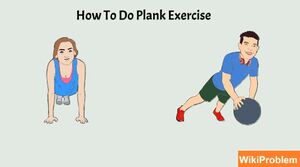How To Do Plank Exercise
From Wiki Problem
A good belly and abdominal workout is the planks. You can always Include the plank in your ab exercise to guarantee that your core remains stable and secure. Any fitness programme should include core stretching exercises. It sounds and looks wonderful to have a strong, robust core. However, it also aids in the stabilization, balance, and power of the body during almost any other exercise. All synchronized and resulting from the rapid motions are built upon strength and flexibility. A strong core can help you attain improved posture by reducing stress on your joints. A core muscle strength and stabilization test can be performed using the plank exercise as a foundation. And here’s how you can do a plank exercise.
Types of plank
- You can Choose a platform that requires you to stretch your entire body length.
- Any workout mat would provide enough cushion to allow you to feel very comfortable on all four limbs.
- You can Start in a plank posture with your elbows and toes on the floor, facing down.
- Your forearms must be facing forward again and your elbows are directly under your shoulder.
- You should really be gazing at the floor with your head straight.
- Draw your navel toward your spine by engaging your abdominal muscles.
- Maintain a tight and straight torso, as well as a straight edge from your ears to your toes with no drooping or bending.
- This is how the spine should be in a relaxed position.
- Your heels should be higher than your toes.
- Hold this position for a total of ten seconds. Allow to fall to the ground.
- Work up to 1 min or more as per your resistance capacity
Forearm Plank
- This variation, which is one of the more popular techniques to complete a plank, is somewhat simpler than simply using your hands to keep your body up.
- You have to Place your forearms on the floor, elbows below shoulders, and arms parallel to your body at hips and shoulders.
- If flat palms hurt your wrists, clasp your hands underneath.
Knee Plank
- This plank is notably more comfortable to control than the typical horizontal planks, making it ideal for novices who want to focus on their form.
- Your lower back will be less stressed if you put your knees on the ground.
- If your knees are unpleasant on the floor, rest them on a wrapped mat or towel.
Side Planks
- This version better strengthens your core muscles than a normal plank.
- You can Lie on your side with one leg stacked on top of the other
- And then raise your body using your hand or elbow, maintaining your feet stacked.
- Raise the opposing arm or leg in the air to make the plank more challenging.
- It will be easier if you cross your higher leg in front of your torso for more stability.
Mistakes to Avoid
- It's critical to consider your head and neck as a continuation of your back.
- Keep your eyes on the ground, about a foot ahead of your hands, to keep your neck in a neutral position.
Forgetting to Breathe
- When you're in a stressful situation, it's natural to hold your breath.
- However, depriving yourself of oxygen can cause dizziness and nausea, which are uncomfortable at best and potentially deadly at worst.
Putting Quite so much Emphasis on the Stopwatch
- Authenticity takes precedence over the number of seconds that pass.
- It's time to walk away when your form starts to deteriorate.
- Take a pause if your back begins to stoop or your shoulders begin to sag.

